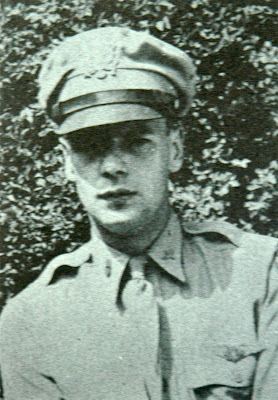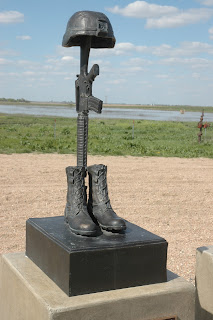Merritt
C. Walton's Biography and the Unique Honor for Sutton’s First WWII Casualty
Area
newspapers reported in January, 1943 the posthumously awarding of the Navy
Cross to Sutton’s first casualty of World War II, Marine Platoon Sergeant
Merritt C. Walton, sometimes known to his family as Cecil Merritt. He received the award
for valor displayed on August 7, 1942 on Gavutu, Solomon Islands when he led an
attack on a Japanese machine gun position that threatened his platoon’s right
flank. The attack was successful but Sgt. Walton was fatally wounded.
The
Navy Cross was only one of two honors, the lesser one I believe, that the Navy
bestowed on this Marine with Sutton connections. More on that other award in a
moment.
 |
| Marine Platoon Sergeant Merritt C. Walton (18 Dec 1916 - 7 Aug 1942), Sutton's first casualty in World War II |
The
first active duty assignment for Sgt. Walton was a three year hitch with the
marine garrison in Shanghai, China. He spent much of 1940 at Mare Island on the
north edge of San Francisco Bay before duty at Lakehurst, New Jersey. The
beginning of World War II brought him to parachute training at Quantico,
Virginia, a short tour in North Carolina and then off to the South Pacific and
the battle for the Solomon Islands.
Sgt.
Walton visited his mother and relatives in Sutton during Christmas, 1941. Area
relatives included his mother, Mrs. Clara Olson, a sister Mrs. Floyd Schwab in
California and his grandmother Mrs. Zenah Walton of Edgar. Sgt. Merritt
Walton’s family connection to Clay County comes from his father Cecil Cullen Walton
who was raised on the Marshall Township homestead of his father, also named Merritt
Walton. The older Merritt Walton’s own father, Isaiah Walton was the family
patriarch, born in Maine, lived in Indiana and came to Edgar late in life. He
is buried in the Marshall Union Cemetery about a mile north of Merritt Walton’s
homestead. A number of Isaiah Walton’s descendants lived in Nuckolls, Fillmore
and Clay Counties and do still today – your author among them.
Sgt.
Merritt Walton’s fatal encounter on Gavutu occurred just seven months after
that Christmas visit to Sutton on the Allies’ first offensive on the island.
The award of the Navy Cross was an appropriate recognition of the bravery of
his actions that day. The Cross is a highly ranked medal in the hierarchy of
Navy medals. But that “other” award is truly noteworthy.
It
may require some personal military experience to fully appreciate the honor
that the U. S. Navy granted to Sgt. Walton. The United States Navy saw fit to
name a ship, a World War II John C. Butler-class destroyer-escort, the USS
Walton after Sutton’s first World War II casualty, Marine Sergeant Merritt C.
Walton. Yes, the Navy named one of their ships after a Marine. Sure, the
Marines are part of the Department of the Navy, but, personal experience
speaking here; it often takes a soldier or an airman to remind seamen and
marines that they are parts of the same organization.
Is
the USS Walton the only Navy ship, or the only ship overall, to have a Sutton
connection? I can’t think of another.
The
Walton was launched on 20 May 1944 in Orange, Texas with Sgt. Walton’s mother
present and sponsoring the ship. The destroyer was commissioned on 4 September
1944. The ship served briefly as a school ship at Hampton Roads, Virginia
before heading to Bora Bora and the Solomon Islands. Her first active wartime
duty was in late January, 1945 as escort to merchantmen ships bound for the
Philippines. Escort duty continued through the end of the war. After the end of
the war, the Walton had the honor or transporting discharge-bound veterans home
arriving in San Pedro, California nine days before Christmas, 1945.
She was decommissioned until the Korean War when she was re-activated and was assigned to Pearl Harbor for a second career as destroyer-escort throughout that war. The Walton became a school house again after the Korean War, this time for Naval Reserve personnel.
Final
decommissioning came on 20 September 1968. In her final act of service to the
country, this time as a target ship she was sunk on 7 August 1969, the 27th
anniversary of the death of Sergeant Merritt C. Walton.
Was
it a pure coincidence that the ship was sunk on the anniversary day of the
death of her namesake? Perhaps, and I’m sure that official Navy archives would
not indicate anything to the contrary. But I also can’t help but speculate that
some Navy Lieutenant with a sense of history, and maybe a sense of humor too,
tweaked the gunnery practice schedule so that the hull of the USS Walton would
be the target on August 7th. As one who was an Air Force Lieutenant
that day in August, 1969, I hope something like that really happened and I
salute that Lieutenant, real or imagined.
The
complete story of the USS Walton can be found at several online locations. Try
these first: http://en.wikipedia.org/wiki/USS_Walton_(DE-361) and http://www.navsource.org/archives/06/361.htm
Then through the wonder of 1940's home movies, check out the USS Walton and its crew on youtube.com ... http://www.youtube.com/watch?v=VtLqe70FW6M&feature=related
And for a better and extensive look at the men who served on the USS Walton, visit the ship's web site at http://usswalton.com/ where you will find dozens, no hundreds of photos taken by crew members during the life of "our" destroyer.
As a distant relative of Merritt Walton, I was very familiar with the story that the USS Walton had been named after Merritt Cecil Walton but I’d associated him with Minnesota and Fillmore County. It came as something of a surprise to find local papers describing Walton as Sutton’s first casualty of World War II. I am proud to include the story of my distant cousin in our collection of Sutton’s veterans, especially as we can make the connection with the destroyer – that definitely adds to this story.
And for a better and extensive look at the men who served on the USS Walton, visit the ship's web site at http://usswalton.com/ where you will find dozens, no hundreds of photos taken by crew members during the life of "our" destroyer.
As a distant relative of Merritt Walton, I was very familiar with the story that the USS Walton had been named after Merritt Cecil Walton but I’d associated him with Minnesota and Fillmore County. It came as something of a surprise to find local papers describing Walton as Sutton’s first casualty of World War II. I am proud to include the story of my distant cousin in our collection of Sutton’s veterans, especially as we can make the connection with the destroyer – that definitely adds to this story.
Sgt.
Walton’s citation for the Navy Cross reads as follows:
“For
extraordinary heroism as member of the First Parachute Battalion, First Marine
Division, in action against enemy Japanese forces on Gavutu, Solomon Islands August
7, 1942. Although fully aware of his extreme personal danger, Platoon Sergeant
Walton voluntarily proceeded to
reconnoiter the position of a hostile machine gun which threatened his platoon’s
right flank. After skillfully spotting the weapon’s location, he courageously
participated in a daring attack and realized success in silencing this deadly menace
before he died of fatal wounds.
“Platoon
Sergeant Walton’s unflinching determination and unconquerable fighting spirit
were in keeping with the highest traditions of the United States Naval Service.
He gallantly gave his life for his country.”

















